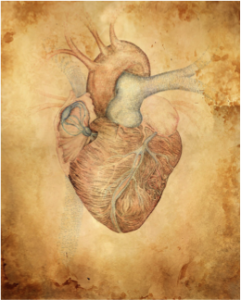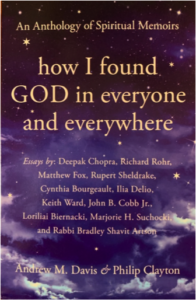
This is the last in an eight-part Northeast Wisdom Home Page Blog series that Cynthia prepared from what she calls “one of the best things I have ever written.” It began on Sunday January 12, 2020, with posts every Sunday and Wednesday during the season of Epiphany. See links for previous postings, and more about the book how I saw God in everyone and everything, at the end of this post. Please share your reflections about the entire series in Comments! Throughout the essay “I Am Not a Space that God Does Not Occupy,” Cynthia deftly weaves her personal inner experience and dynamic relationship with God and life—from the time of her childhood to the present—with that of our common human history of consciousness. In Part VII, she shares how initially it was her personal trajectory with Centering Prayer that led her to a clearer seeing and experience of what it is to perceive with the eye of the heart. Tracing the profound nature of Jesus’ own words, “Blessed are the pure in heart for they shall see God,” into the consciousness of our times; Cynthia opens and concludes Part VII with contemporary words of Wisdom. “See or perish,” says Teilhard; while Kabir Helminski speaks to the heart as an organ with subtle faculties that—when working together—are “in spontaneous connection with the cosmic mind. This total mind we call heart.” This, says Cynthia, is a “revelation…or perhaps a revolution!” More about that, here in the conclusion…
Part VIII: The Eye of the Heart

During the ten years or more it took for this other way of understanding to be gradually assimilated in me, I slowly awoke to the real “aha!” of the situation. The thing is, pantheism, panentheism, monotheism—all those other grand “isms’ of the Western philosophical mind—are purely functions of the operating system, the rational mind running its perception-through-differentiation program. They are based on there needing to be an inside and an outside, a subject and object, carefully delimited descriptors, and identity through differentiation. And in all those respects, the concept of a great transcendent God “out there” is totally and quintessentially a function of separation consciousness at work, of the rational level of consciousness which was the great first axial breakthrough.

But that is two levels of consciousness below where we are now, and where we need to be moving much more swiftly if there is to be a future for this fragile and interconnected universe. At the pluralistic level (where most of liberal/ progressive consciousness is presently clustered), we are just beginning to put the separated bits and pieces back together under the banner of “co-exist.” At the next level, the integral, we have begun to think holographically, from the whole to the part (rather than from the part to the whole which is still paradigmatic for pluralistic consciousness.) But only at the birth of the genuine nondual does the upgrade happen; the mind sinks into the heart, and we literally perceive FROM NO SEPARATION, by matching the pattern. There is no inside and no outside, because they are no longer necessary for perception. “When you can make two become one, the inside like the outside, the higher like the lower…” says the gospel of Thomas (logion 22). When you can look at the laborers in the vineyard (Mt 20) and not immediately rank them on the grid of “more” and “less.” When you begin to see in a dynamic, intercirculating, interabiding, cosmotheandric way that preserves both particularity and unity by setting the whole scene in motion, then, like Barbara Brown Taylor, you will hear yourself saying:
At this point in my thinking, it is not enough for me to proclaim that God is responsible for all this unity. Instead, I want to proclaim that God is the unity—the very energy, the very intelligence, the very elegance and passion that makes it all go. (The Luminous Web, p. 74)
In former days, this kind of seeing was often confused with a mystical experience or hyped as evidence of “enlightenment” or personal self-realization. And maybe this was indeed the case in former days, and I can pat myself on the back if I want for having glimpsed something once reserved to the saints and mystics. But then there’s my grandson Jack, whose query began this essay (see Part I: The Light Within). At four, Jack was already clearly thinking in terms of the total volume of wholeness. It’s no longer an over-the-top spiritual achievement. It’s simply the way the planet is evolving.

I know that the direction and rate of acceleration nowadays leave a lot of us boomers who are still invested in the orderly transmission of institutional Christianity quaking in our boots. But you see, the light at the end of the tunnel in all this is that Jesus was THERE already, two thousand years ago. And as we open our mystical eye-of-the-heart and see, what we see is a Christianity which has essentially been waiting in the wings for two millennia for the time to arrive when it can finally become consistent its own highest cosmotheandric calling:
“As you, Father, are in me and I am in you, may they also be in us…I in them and you in me, that they may be completely one.” (John17: 21-23)
This is last post in the series, “I Am Not a Space that God Does Not Occupy…” here on the Northeast Wisdom Home Page Blog. You may click on these links to go to “Part I: The Light Within,” “Part II: Panenthesim,” ” Part III: Panikkar,” “Part IV: Jesus Was Not a Monotheist(!?)” and “Part V: A Brief History of Consciousness,” “Part VI: A Brief History of Consciousness, continued.” and Part VII: Seeing.
May this “year of perfect vision” indeed shed some new light.
As the new decade gets underway, it feels like an appropriate moment to share one of my earlier essays, which is still to my mind one of the best things I’ve ever written. It was originally published in the 2018 anthology, how I found GOD in everyone and everywhere… Enjoy! And Happy New Year!!!
“how I found GOD in everyone and everywhere is an anthology of spiritual memoirs, edited by Claremont School of Theology faculty members Andrew M. Davis and Philip Clayton and published by Monkfish, our intrepid publishing partner here in Northeast Wisdomland! Compiled in honor of Marcus Borg, this anthology is broadly structured around the theme of Panentheism and features the usual suspects among Christian nondual teachers, including my colleagues Richard Rohr, Matthew Fox, and Ilia Delio. It’s well worth a read in its entirety.”
~ Cynthia Bourgeault, January 2020
We look forward to the conversation continuing in Comments!
Read other posts in the series:
“I Am Not a Space that God Does Not Occupy”


Thank you, Cynthia, for your teachings and your conscious service. We read the eight parts aloud, as Lectio readings. Absorbing the words, containing them, allowing them to blossom however and whenever they will. I have reached a place on this path where the need for understanding has been greatly quieted. Many pieces of the Whole have landed in a place beyond understanding. Keeping my inner receiver tuned to the Resonance Channel carries me forward.
Separation is apparent and not real. Differentiation is real and often not apparent. The West is built on separation though there is no separation and all is one. All is one, and the one is God. I think children, for maybe the first 18 months, live in oneness consciousness, and we lose it as we get conditioned and indoctrinated to see separation as we get older. Closeness to babies, which mothers get to have first and most while fathers get much less, is so wonderful and therapeutic because it is closeness with oneness and God. I believe Jesus had and abided in that oneness consciousness, maybe to a greater degree than anyone else. I believe he (like some others most notably Buddha) wanted us to have that consciousness and live a Way that gets us there, but instead we separated Jesus from us and made him an object of worship.